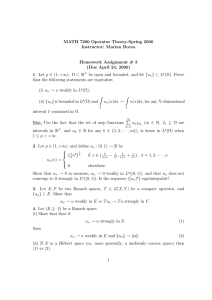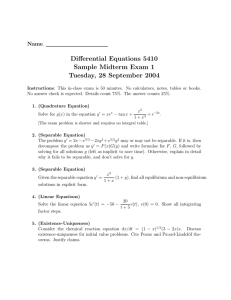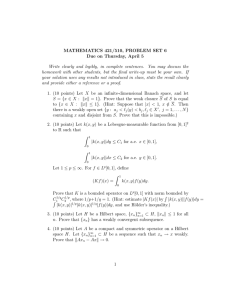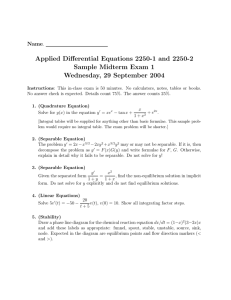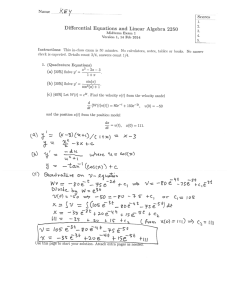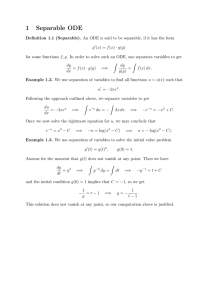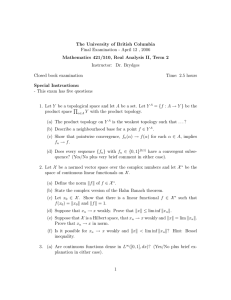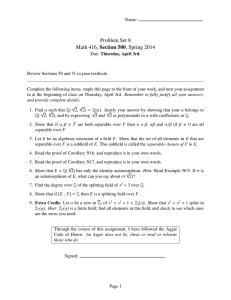Functional Analysis Ph.D. Comprehensive Exam
advertisement
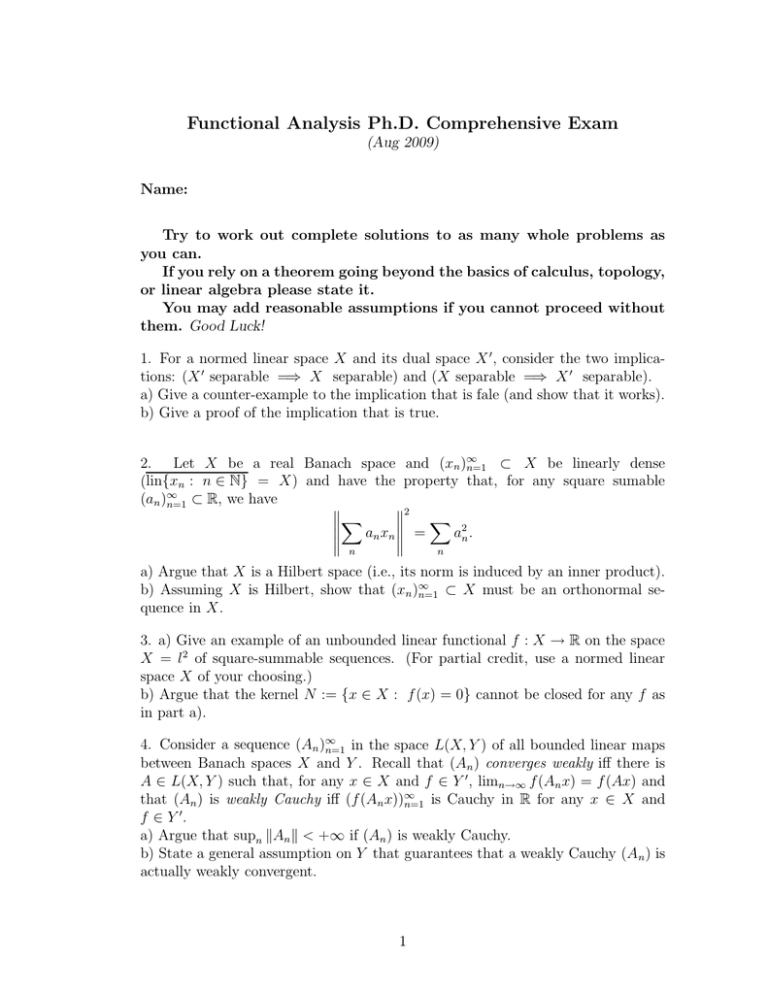
Functional Analysis Ph.D. Comprehensive Exam
(Aug 2009)
Name:
Try to work out complete solutions to as many whole problems as
you can.
If you rely on a theorem going beyond the basics of calculus, topology,
or linear algebra please state it.
You may add reasonable assumptions if you cannot proceed without
them. Good Luck!
1. For a normed linear space X and its dual space X 0 , consider the two implications: (X 0 separable =⇒ X separable) and (X separable =⇒ X 0 separable).
a) Give a counter-example to the implication that is fale (and show that it works).
b) Give a proof of the implication that is true.
2. Let X be a real Banach space and (xn )∞
n=1 ⊂ X be linearly dense
(lin{xn : n ∈ N} = X) and have the property that, for any square sumable
(an )∞
n=1 ⊂ R, we have
2
X
X
a n xn =
a2n .
n
n
a) Argue that X is a Hilbert space (i.e., its norm is induced by an inner product).
b) Assuming X is Hilbert, show that (xn )∞
n=1 ⊂ X must be an orthonormal sequence in X.
3. a) Give an example of an unbounded linear functional f : X → R on the space
X = l2 of square-summable sequences. (For partial credit, use a normed linear
space X of your choosing.)
b) Argue that the kernel N := {x ∈ X : f (x) = 0} cannot be closed for any f as
in part a).
4. Consider a sequence (An )∞
n=1 in the space L(X, Y ) of all bounded linear maps
between Banach spaces X and Y . Recall that (An ) converges weakly iff there is
A ∈ L(X, Y ) such that, for any x ∈ X and f ∈ Y 0 , limn→∞ f (An x) = f (Ax) and
that (An ) is weakly Cauchy iff (f (An x))∞
n=1 is Cauchy in R for any x ∈ X and
f ∈ Y 0.
a) Argue that supn kAn k < +∞ if (An ) is weakly Cauchy.
b) State a general assumption on Y that guarantees that a weakly Cauchy (An ) is
actually weakly convergent.
1
5. Let X be a Banach algebra (with an identity). Recall that x ∈ X is a unit iff
x−1 exists in X and that x ∈ X is a topological divisor of zero iff there is (xn ) ⊂ X
such that kxn k = 1 yet either xn x → 0 or xxn → 0.
a) Show that if x is in the boundary of the set of all non-units, then x is a topological
divisor of zero.
b) Describe explicitly the boundary of the set of all non-units for the algebra
C([0, 1]) of all continuous real valued functions on [0, 1].
6. On X = L2 ((0, ∞)), consider the class of densely defined linear operators
A : X ⊃ D(A) → X that are symmetric, i.e., hAx|yi = hx|Ayi for all x, y ∈ D(A).
a) Argue that any A in this class with D(A) = X must be bounded.
b) Show that σ(A) 6⊂ R for A = i dtd defined on all smooth compactly supported
u : (0, ∞) → C. (This A is in the class.)
7. On the space L2 (Z) of two-sided square sumable sequences, consider the operator
∞
A : (xk )∞
k=−∞ 7→ (xk−1 + xk+1 )k=−∞ .
a) Explain why the residual spectrum of A must be empty.
b) Compute the spectrum σ(A) and describe (as explicitly as you can) the spectral
resolution (E(λ))λ∈R associated to A.
8. Let A : X → X be a linear operator on a complex Hilbert space such that A∗ A
is compact.
a) Show that A is compact.
b) Show that Y := {x ∈ X : Ax + x = 0} is finite-dimensional.
√
c) Assuming A is also self-adjoint and positive, explain how one can define A.
2
The gist of solutions:
1. X 0 separable =⇒ X separable, not vice versa because (l 1 )0 ' l∞ is not
separable while l1 is separable. The implication is a standard theorem the proof of
which can be found in a text.
P
2. a) The hypothesis assures that X is isometric to l 2 via (ak ) 7→
ak xk . In
particular, the norm on X satisfies the parallelogram identity.
b) Use the (real) polarization to compute hxk |xl i in terms of the norms kxk ± xl k.
3. a) Extend the standard ON basis (en )n∈N of l2 to a basis (en )N∪Λ of l2 as
a linear space over R. (This linear algebraic basis is often called a Hamel basis.
Its existence rests on Axiom of Choice or Transfinite Induction. We note that
the index set Λ is uncountable.) Take a nontrivial bounded linear functional, say
f0 ((xk )) := x1 . Fix n0 ∈ Λ. Let f : l2 → R be the unique linear functional given
on the basis by f (en ) = f0 (en ) for n 6= n0 and f (en0 ) = f0 (en0 ) + 1. Then f is
linear and everywhere defined and coincides with f0 on the ON basis, so it would
have to be equal to f0 if f were continuous.
b) One quick argument is to note that if N is closed then f factors into the canonical
projection X → X/N followed by a 1-dimensional linear map X/N ' R → R, both
of which are continuous. There is however a “more honest” direct argument ...
4. a) This is a standard fare resting on invoking PUB, twice.
b) Also standard. To define Ax, one needs reflexivity of Y in order to parley the
bounded functional Y 0 3 f 7→ limn→∞ f (An x) into an element of Y , which is the
sought after Ax.
5. a) Suppose that x can be approximated by units xn yet x−1 does not exist.
−1
Then it must be that kx−1
as
n k → ∞ (as otherwise Neumann series generates x
−1
a perturbation of xn ). Hence
x−1
x−1
x−1
1
n
n
n xn
x
=
(x
−
x
)
+
→0+
= 0.
n
−1
−1
−1
kxn k
kxn k
kxn k
∞
b) All continuous f : [0, 1] → R that have zeros but do not change sign.
6. a) This is a Herllinger-Toeplitz Theorem, which rests on checking that A is
closed and applying CGT.
b) The equation (A − λI)u = f is an ODE that solves to
Z
1 t iλs
−iλt
e f (s)ds .
u(t) = e
u(0) +
i 0
Taking into account that u(0) = u(t) = 0 for t > t0 where t0 is sufficiently large
(depending on u), we see that, for f ∈ R(A − λI),
Z ∞
eiλs f (s)ds = 0
0
3
which is to say that
hf |gλ i = 0
where gλ : s 7→ e−iλs . Note that gλ ∈ L2 ((0, ∞)) as long as Im(λ) > 0, in which
case gλ belongs to R(A − λI)⊥ placing λ in the residual spectrum of A.
7. We all know that 2π = 1.
a) The reason is that A is a bounded normal operator (so kAxk = kA∗ xk, which
gives R(A)⊥ = N (A∗ ) = N (A)).
b) Use the Fourier series to move the dicussion to L2 ([0, 1]) (really to L2 (T1 ))
where A becomes the multiplication by φ : [0, 1] → R given by φ(t) := 2 cos(t).
Therefore, the spectrum equals the range of φ, which is [−2, 2]. For λ ≥ −2, the
spectral resolution E(λ) corresponds to the multiplication by the characteristic
function χφ−1 ([−2,λ]) . For λ ≤ −2, E(λ) = 0.
8. a) Use hAxn − Axm |Axn − Axm i = hA∗ Axn − A∗ Axm |xn − xm i to see that
if (A∗n Axn ) is Cauchy then so is (Axn ).
b) On Y , A = −I, which can only be compact if Y is fin-dim.
c) There are many ways. One is to write out the binomial power series (convergent
for 0 ≤ A ≤ I, which can be
√ secured by scaling). Another is by squaring the
eigenvalues and synthesizing A via the spectral resolution.
4

